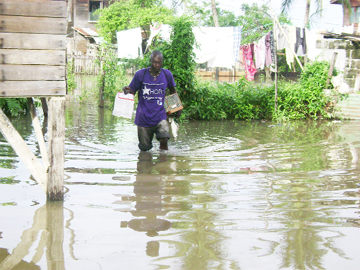Chief Executive Officer of the Guyana Telephone and Telegraph Company (GT&T) and former head of Conservation International, Major General (ret’d) Joe Singh has said that the longer term outlook for climate change and its implications for changing weather patterns dictate that Guyana’s response to the economic and social impact of coastal flooding go beyond the current disaster preparedness and recovery programmes that are being employed to respond to the situation.

“The time has come for people to understand that unless we can raise the sea wall and place a huge umbrella over coastal Guyana we must begin to think seriously about developing infrastructure in areas that are not going to be flooded and where different types of employment and homesteading can be made available.” Singh told Stabroek Business.
And the former Army Chief of Staff told Stabroek Business that he believes that funds accruing to Guyana as carbon credits arising out of the preservation of its forests ought to be used, in part, to address the costs of making those adjustments. “The President to his credit, has said that there must be a value placed on the resources that we have in the context of a low-carbon economy. There has to be a recognition of this and a compensatory mechanism that values that resource and that money has to be allocated not only to the maintenance of infrastructure but also to more strategic development work to alleviate those problems that are going to continue over the longer period.”
Noting that the current heavy rainfall is now likely to be an annual feature Singh said that the Guyana situation had to be viewed from the standpoint that the coast is sandwiched “between a conservancy and an angry sea. According to Singh, unless Guyana is prepared to spend hundreds of millions of millions of dollars “no amount of drainage and irrigation, in my view, will solve the problem. We are in a bowl and that’s the reality,” Singh declared.
The former army Chief of Staff said that he had recently visited the Dazzell Housing Scheme on the East Coast “where people had put their life savings into their homes.” He said that there was no single yard in that housing community that had not been flooded. “Children are confined to their homes. Animals are foraging on the roads. Some people who have got land elsewhere are relocating their livestock.”

And according to Singh while in the present situation it was important the people protect what we have to the best of their ability, the longer term solution had to be more comprehensive. ‘It cannot be that that is the solution. The time has come for us to sensitize people to the reality of the situation and to what the longer term solution is,” he added.
Singh said that given the fact that Guyana is not an island there were options to continually enduring coastal flooding. “We have options. We are not Grenada or a Trinidad and Tobago or any other island. We do not need to endure this punishment. Some expenditure needs to be directed towards infrastructure in areas that offer alternative employment, security and other amenities,” Singh said.





